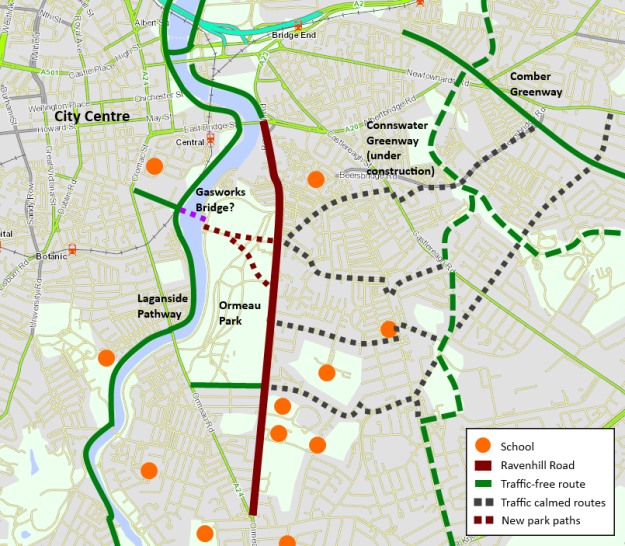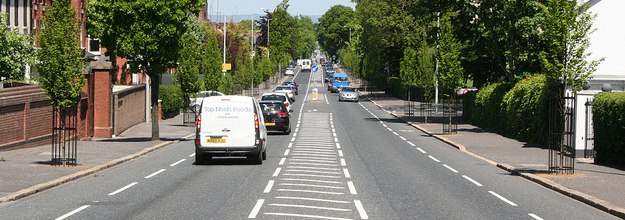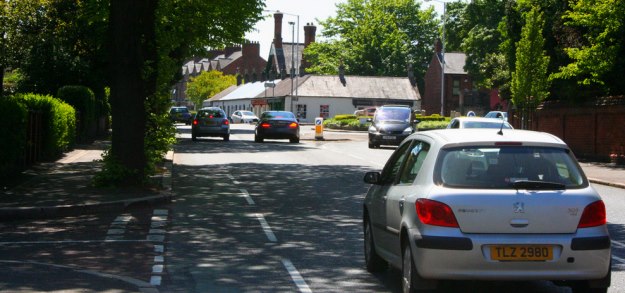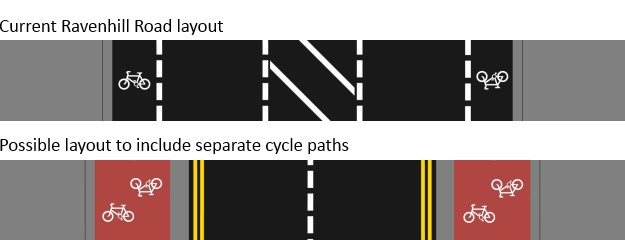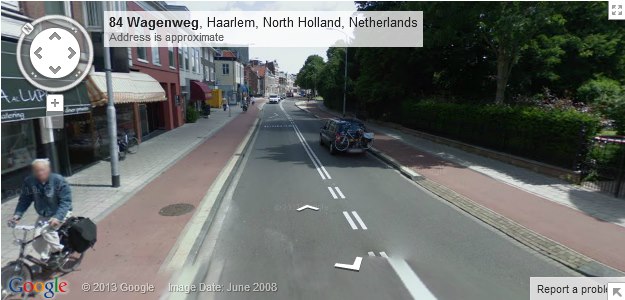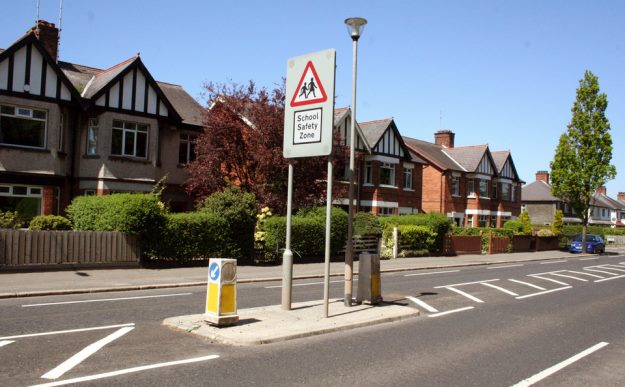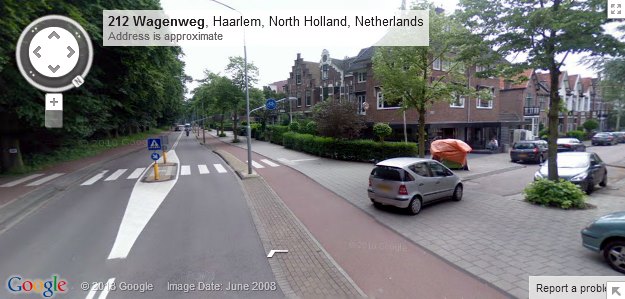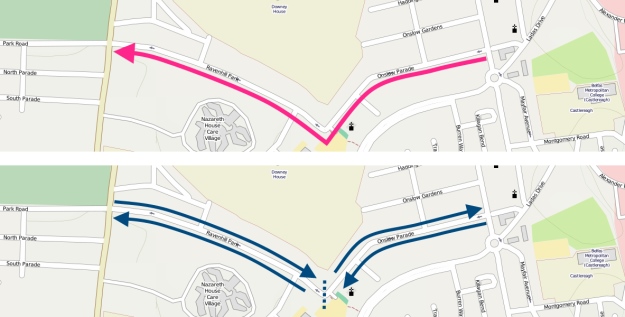Belfast is in the middle of a mini active travel boom, mainly driven by rising numbers of bike commuters. But Belfast suffers from structural issues which hold back cycling development, not least the physical barrier of the River Lagan. One plan to provide relief, a new pedestrian and cycling bridge linking the Gasworks site to Ormeau Park, has been largely forgotten. Why?
The Gasworks Bridge would span 140m between the Lagan entrance to the Gasworks Site and the Ravenhill Reach car park beside Ormeau Park. The project cost is estimated in the region of £4million to £8million. The benefits to the city have been clear for many years:
- greater access for people in South and East Belfast to the city centre
- making Ormeau Park a city centre park, accessible by both residents and workers, 15 minute walk from City Hall
- provide safer pedestrian and cycling options than Albert Bridge and Ormeau Bridge
- increase in walking and cycling with the health, leisure and transport benefits
- further encouraging inner city regeneration with a new signature city gateway
This would be the first standalone bridge to be built in Belfast solely for cycling and walking journeys – an important signal of intention to follow through on active travel promotion. Local residents surveys have always returned positive views, with few concerns about potential interface issues. All very positive, but it seems to have dropped off the agenda.
Why is it important?
The spine of the National Cycle Network runs along the western bank of the River Lagan here, connecting a traffic-free route stretching from Lisburn to Newtownabbey, a developing connection to the Comber Greenway (and the Connswater Greenway project) and hopefully all the way to Bangor in the future. The embankment cycle tracks and shared pathways have contributed to an upsurge in active travel, with cycling flow increases of over 250% observed between 2000-2010 (PDF, 499k).

Adding the bridge would open up east-west journeys on the National Cycle Network, increasing the potential of the Gasworks Park pathway which links almost directly into the city centre. The Gasworks Park hosts large employers like Lloyds and the Northern Ireland Environment Agency, but also the Radisson SAS Hotel. The bridge would not only be a commuter and lunchtime leisure option, but also a tourist facility.
For walking journeys to work, Shaftesbury and Botanic wards lead the way with over 40% of commuter ‘traffic’ on foot. Yet just across the river there is a sharp drop-off with Woodstock and Ballynafeigh wards around 25% and Ravenhill less than 20%. Physical disconnection is at least partly responsible, with long diversions needed to reach the main employment base in the city centre.
The communities surrounding Ormeau Park are also at the forefront of the the current cycling boom. While still quite low levels compared to proper cycling cities around the world, nonetheless Woodstock, Ravenhill and Ballynafeigh are the top 3 wards in the whole of Northern Ireland by cycling commuter share at 5-6%.

A startling 51% of households in Woodstock have no access to a car or van (Census 2011) over double the rate of Northern Ireland as a whole. Direct traffic-free access into the city centre is both desirable and necessary here.
Belfast has seen a 60% rise in cycling commuters between 2001 and 2011. If a Gasworks Bridge contributed to a doubling of cycling levels in these top 3 wards by 2021, cycling levels would outstrip even bus commuting here, which begins to fundamentally change the inner city transport dynamics.
By upgrading cycling routes beyond Ormeau Park, across traffic-calmed residential streets towards Cregagh and Castlereagh Roads and the two Greenways, a genuine and attractive alternative to car travel becomes possible for a large part of South East Belfast. A positive impact on inner city traffic levels must be considered a key element of the bridge’s benefit.
What are the alternative cycling commuter routes?
The existing connections between the city centre and the suburbs of South and East Belfast have become scenes of cycling commuter stress and conflict. The area is poorly served by just two main access points across the Lagan a mile apart, the Ormeau Bridge and the Albert Bridge.

The Albert Bridge is awful for cycling, with it’s narrow road space, ugly crash barriers and no safe cycle space. Roads Service estimates 50% of cyclists use the narrow footpaths rather than the road. Yet as a listed bridge (built in 1890) the options for change are apparently limited.

The Ormeau Bridge has a more open feel, but again has no dedicated cycling space. The ghost bike memorial for Michael Caulfield is a stark reminder of how dangerous our roads are for cycling – more so as the Ormeau bridge and embankment intersection is probably the busiest area in Northern Ireland for commuter cycling.
Why has the project faltered before?
Planners have had their eye on a bridge here for decades, but not always for a footbridge. In the rush to build for a motorised future, 1960s plans foresaw an urban motorway running around the Gasworks site and over to Ravenhill. While the motorway plan thankfully fell away in the 70’s, the idea of a more modest distributor road bridging the Lagan and running to the Ravenhill Road lingered through to the 1990s. Along with the main plan for a southern inner ring road, currently in limbo, this has contributed to urban blight through restricted development along the Bankmore corridor.

Lately with the recognition that a road scheme would not be viable or attractive, and the redeveloped Gasworks site opening in 2001, the idea of a traffic-free bridge moved up the agenda. Boosted by the inclusion in the Belfast Metropolitan Transport Plan 2015, it seemed obvious that the bridge would be built quickly, given the success of the wider Gasworks and Laganside projects:
“Two new pedestrian/cycle bridge crossings are proposed to serve key activity spines between the east and western sides of the River Lagan. These will improve the connection between the extension of existing riverside walkways and the more strategic sections of the pedestrian network. These bridges will be funded as part of the regeneration of Belfast.”
Rumblings of trouble can be seen in a Belfast City Council Development Committee report from 2005, when you look at the number of ‘stakeholders’:
- Laganside Corporation – Gasworks and riverside regeneration
- Department for Social Development (DSD) – public realm schemes and Laganside Corporation’s sponsor
- Belfast City Council – owner and operator of land and facilities on both sides of the river
- Sustrans – the National Cycle Network runs through the middle of the issue
- Department of Regional Development (DRD) – NI transport planning and infrastructure, including active travel
Lots of interested parties, but no-one to take a clear lead. It was unfortunate timing that the Laganside Corporation was wound up within 2 years of this, having reached £1 billion of investment in the city.
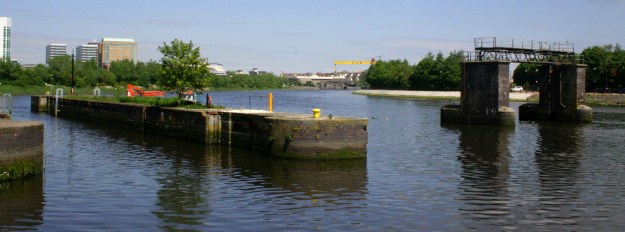
The last major push was around 2009, with talk of the project even being linked to the failed national stadium bid at Ormeau Park. An application for Special EU Programmes Body (SEUPB) Peace III funding “fell down on its demonstration of peace and reconciliation outcomes and its ability to provide a lasting legacy to the peace programme”.
If we’re relying on a 140m river crossing to be a transformative factor in community relations and breaking down sectarian divisions, what hope is there for Northern Ireland? EU Peace funding has been practically ruled out, and the reason is clear when you cut through the ‘additional’ benefits and set out the purpose of the bridge in basic terms:
The project’s most important function is to provide a new transport corridor in Belfast.
Therefore it falls squarely within the remit of DRD and their executive agency Roads Service. A Belfast City Council Development Committee report on the potential construction and maintenance of the bridge from back in 2005 shines a troublesome light on DRD active transport thinking:
“It is obvious that responsibility for the project should be taken up by Roads Service. Initial contact with Roads Service has however been met with a lukewarm response despite the rhetoric in the BMTP etc in regard to walking and cycling as valid means of transport.”
Can DRD to demonstrate they have moved beyond this point, and take ownership of a major project exclusively for active travel? Is there a golden window of opportunity given the ongoing difficulties with the A5 road project?
What is the way forward?
The recently opened Peace Bridge in Derry~Londonderry is a fantastic local example of what can be achieved for urban cycling and walking transport. Around 2,300 people use the bridge every day, and is a challenge to Belfast to replicate or exceed this impressive performance.

For an international comparison, Copenhagen is one of the leading cities in the world for urban cycling, with a journey share of around 36%. But it’s a city still trying striving to improve, and leading this charge with urban bridge building for non-motorised traffic with the Copenhagen harbour bridges project.
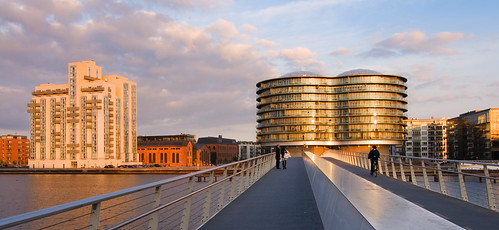
The Gasworks Bridge is a key element of re-imagining and reworking central Belfast. Council plans are afoot for sweeping regeneration from the Markets area to Sandy Row and Shaftesbury Square. The bridge would open up new possibilities for commuting, leisure, shopping and social trips that aren’t really viable today. It’s easy to overplay the significance, but the bridge even has the potential to help boost the evening economy in the city.
The Gasworks Bridge is a key part of the Belfast Metropolitan Transport Plan 2015, which is still used to determine capital project priority in the current budget period. If the DRD Minister should wish to leave a legacy for Belfast which provides positive encouragement to reduce car journeys, he would struggle to find a better opportunity than the Gasworks Bridge.
.
[youtube http://www.youtube.com/watch?v=GtjBjgHkAAM?rel=0]
What do you think about the idea of a Gasworks Bridge? Will it encourage you to ditch the car? Comments are open below..
*** UPDATE *** 20th June 2013 *** UPDATE ***
A week is a long time in politics, and one week on from this post there is stunning news. Regional Development Minister Danny Kennedy, while addressing the Politically Painless Active Travel conference in Belfast, announced he is to commission a feasibility study into the Gasworks Bridge project!
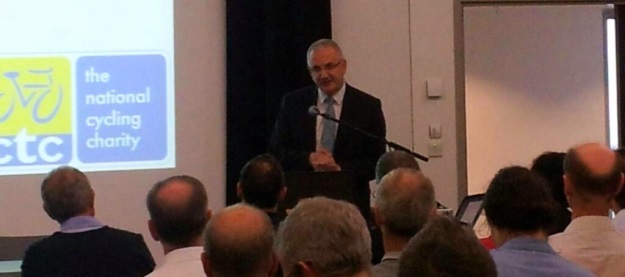
This is great news for the local community, active travel organisations, councillors and many others who have put in the real work over a decade to see this bridge built. Hopefully DRD / Roads Service will make swift progress, and the project’s overwhelming benefits will ensure a positive outcome. The potential to transform this part of Belfast is immense – with Belfast cycling on the rise, it seems the Gasworks Bridge’s time has come!

